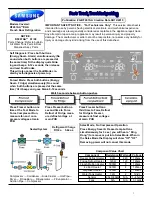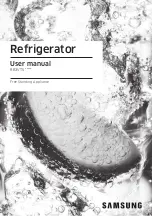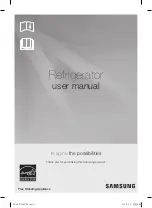
24
Tips for using this appliance
• Before storing cooked foods in the refrigerator, allow them to cool to room temperature.
Never put hot or even warm foodstuffs into the freezer.
• To maintain adequate air circulation, do not overfill the appliance. If there is too much food
inside, the compressor does not work as effectively.
• Do not open the door any more than necessary - this will keep the temperature as cold as
possible inside.
• Wrap or cover food well before storing. Always make sure that any packaging is airtight and
suitable for use inside a fridge.
• Successful freezing depends on the correct packaging. Prior to freezing the food, food should
always be covered tightly with foil, plastic film, placed in plastic bags or stored in airtight
containers. This will prevent food from dehydrating and to prevent any strong odors of some
foods transferring to milder ones.
• All frozen food you purchase should be placed in the freezer as soon as possible to avoid
them from defrosting and spoiling. All storage recommendations printed on the packaging of
frozen food by the manufacturer should always be followed.
• You may hear gurgling noises or a humming sound while the appliance is in use and this is
perfectly normal when the compressor is running and the coolant is moving through the
system.
• A clicking sound may be heard, this is the thermostat and is normal.
• This appliance is designed to operate in an ambient temperature between 16 and 32 °C.
• Do not exceed the storage times recommended by the food manufacturer and always check
expiry dates.
Cleaning your refrigerator
Before you start to clean your refrigerator set the temperature control off and remove the plug from
the power supply.
Use a clean sponge or a soft cloth and a mild detergent in warm water. Do not use abrasive or harsh
cleaners.
Do not use cleaning waxes, concentrated detergents, bleaches or cleaners containing petroleum on
plastics and rubber parts.
Never use paper towels, window sprays, scouring cleansers or flammable fluids on plastic parts as
these can scratch or damage the appliance.
Hand wash, rinse and dry all surfaces thoroughly.
Avoid getting water into the electric components of the appliance (i.e. the thermostat) or spilling
water on the fridge.
If the refrigerator is not in use for a long period of time, you should clean the appliance as detailed.
Leave the door open to prevent any unpleasant smells inside.
Defrosting
Defrosting refrigerator compartment:
• Defrosting process is automatic by thermostat knob. The melted frost flows into the drip tray
and will automatically evaporate.
Defrosting freezer compartment:
• Defrosting for the freezer compartment is by manual process.
• Remove the mains plug from the wall socket, open the door and remove all the food to a
cool place. Defrost using a plastic scraper or let the temperature rise naturally until the frost
melts. Then wipe away the remaining ice and water, after this plug the freezer back into the
mains supply.
Note: To avoid damaging the freezing compartment wall, do not use any sharp objects to
remove the frost or separate the frozen food.
GB
Содержание LIFR119
Страница 1: ...INSTRUCTION MANUAL FRIDGE LIFR119 ...
Страница 2: ...NL Thermostaat Legger Deurrek Groentelade Verstelbare voetjes ...
Страница 8: ......
Страница 9: ...FR Thermostat Planche Etagère de porte Bac à légumes Pied réglable ...
Страница 15: ......
Страница 16: ...20 GB Thermostat Shelf Door shelf Crisper Adjustable feet ...
Страница 22: ......




































